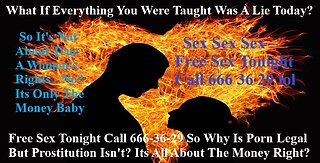Premium Only Content

Black Sex Slave Fight For Sexual Justice During Reconstruction Female Slave Owners
Why is America the greatest country in the world ? America is not the greatest country in the world anymore. He then gives a litany of factual reasons why. America lags other nations in the world in a large number of areas, from infant mortality and crime rates to median income and gross domestic product per capita. Politicians, doctors, public policymakers, economists and academics have tried to narrow these gaps for years. Did Obama really say, "they bring a knife we bring a gun" without getting impeached ? Yes, and even crazier, Teddy Roosevelt was never impeached for carrying a big a stick. Most people, even now, know the difference between literal and figurative speech. Largely Slave, they have been unsuccessful. Fight for sexual justice during Reconstruction In a public lecture given in 1833, Maria W. Stewart, a pioneer black abolitionist and women’s rights advocate, invoked black women’s demands for sexual justice by asking, “What if I am a woman?”1 It was a question with profound implications if answered in the affirmative. What would it mean to acknowledge women, especially black women, as full citizens with legal capacity and political consent? If black women were granted not just the rights of life, liberty, and happiness, but also self-sovereignty, then they would also be entitled to the legal protection of those rights. By asking the question, Stewart asserted the essential humanity of black womanhood and called for the inclusion of black women as fully human and autonomous beings, the “owners” of their own bodies with the ability to withhold consent.
Stewart, like many black women, insisted on sexual justice as a natural right. In doing so, black women and their allies influenced the Republican Party’s vision of racial equality over the course of the 1850s through the end of Reconstruction. And their radical campaigns for sexual justice taken together with evolving Republican ideas about legal equality made possible the emergence of a new sexual citizenship.
Maria Stewart called for women’s rights and joined the abolitionist fray in 1831, publishing her first essay in the antislavery newspaper the Liberator.2 Acknowledging black women’s sexual vulnerability, Stewart opened with a prayer, “O that my head were waters, and mine eyes a fountain of tears, that I might weep day and night [Jeremiah 9:1], for the transgressions of the daughters of my people.”3 Stewart knew that in most states, black women—free and enslaved—were excluded from rape laws.4 In fact, no Southern states made it legally possible for slave women to file rape charges against a white man before 1861. Thus existing outside the legal definition of rape and in the cultural imagination as a prostitute at best and a sexual beast incapable of virtue at worst, a slave woman had few options.
In the same year that Stewart published her antislavery pamphlet calling for the protection of black womanhood, Mary Prince published her autobiography, The History of Mary Prince, a West Indian Slave. The first female slave narrative, Prince’s autobiography exposed the sexual violence masters committed against their slaves and made visible black women’s resistance to these acts. She recounted in graphic detail the physical and psychological violence that slaves suffered at the hands of their masters and mistresses. She recalled how her new mistress taught her not only “to do all sorts of household work” but also “to know the exact difference between the smart of the rope, the cart-whip, and the cow-skin” when applied to her naked body.5 The sexualized beatings that Prince withstood at the hands of both mistress and master functioned as brutal reminders that her body was not her own.
Limited in what she could recount by Victorian ideals that censored what a “respectable” women could say publicly about rape, Prince described Mr. D as an “indecent master” who forced her to bathe him. “This,” she confessed, “was worse to me than all the licks.” Unable to state overtly the sexual violence implicit in Mr. D’s demands, Prince instead spoke of her “shame” and her efforts to resist. On one occasion, she recalled, “He struck me so severely … that at last I defended myself, for I thought it was high time to do so … he was a very indecent man … with no shame for his servants, no shame for his own flesh.” By highlighting her resistance without transgressing Victorian norms of delicacy and propriety, Prince challenged the notion that slave women lacked virtue and welcomed white men’s sexual advances.
The recognition of master/slave rape soon became a standard part of the American abolitionist bill of indictment against slavery. Writing under a pseudonym, former slave and abolitionist activist Harriet Jacobs recounted her master’s sexual power over her in the best-known slave account on the impact of sexual violence on black women, Incidents in the Life of a Slave Girl, and similar, imagined incidences became a fixture in the antislavery fiction of white abolitionists, such as Harriet Beecher Stowe’s Uncle Tom’s Cabin. Indeed, by the 1850s there were few slave narratives that did not mention the sexual exploitation of female slaves.6
The rape of slave women and their resistance also figured prominently in some of the most momentous legal and political battles over slavery in the decade leading up to the Civil War.
The 1855 case of Celia, an 18-year-old slave woman in Missouri who was tried and executed for killing her master after years of rape, raised the question of a slave woman’s right to defend herself against sexual violence. Despite popular belief that black women were sexually lascivious and could not be raped, Celia insisted on her right to withhold consent and defend herself.7 Celia could not speak on her own behalf because Missouri law prevented blacks from testifying against white people. Nonetheless, Celia’s defense argued that Missouri rape laws, which made it a crime “to take any woman unlawfully against her will and by force, menace or duress, compel her to be defiled,” applied to Celia, a slave woman.
To recognize Celia as a rape victim would require acknowledging her as a person deserving of humane treatment and legal protection; indeed, such recognition would call into question the entire legal system of slavery. While Celia’s lawyers ultimately failed to save her life or to overturn legal precedent that defined slave women outside the criminal definition of rape, Celia succeeded in making visible black women’s campaigns for human dignity and sexual justice.
The 1857 Dred Scott decision also fueled political debates about the sexual exploitation of slave women. Indeed, the case reveals that by the late 1850s, Republicans had begun to integrate black women’s campaigns for sexual justice into their political ideas about equality and citizenship. Abraham Lincoln reminded his audience that not just Dred Scott’s freedom was at stake in the case, but also the freedom of Scott’s wife, Harriet Robinson, and their two young daughters, Eliza and Lizzie. Making clear his opinion, Lincoln explained, “We desired the courts to have held that they were citizens … that they were in fact and in law really free,” and concluded that the ruling also meant the girls would be “left subject to the forced concubinage of their masters.”8 Drawing attention to master/slave rape, Lincoln flipped the sexual script to argue for Eliza’s and Lizzie’s rights as citizens to withhold consent.
Republicans were not immune to racial prejudices, but as Lincoln made clear, the party believed free blacks were entitled to the natural rights of mankind articulated in the Declaration of Independence. Equal protection under the law, however, did not include political or social rights for black women as far as Lincoln or the majority of the Republican Party was concerned, though it did include a vision of sexual justice articulated by black women.
The arrival of Union troops in the South intensified master/slave violence and exposed black women to a new kind of sexual violence at the hands of soldiers. At the same time that the war made black women even more vulnerable to rape, the passage of new military laws under Lincoln’s Lieber Code of 1863 brought all Southern black women under the umbrella of legal protection. Defining rape as a war crime without regard to race, the code reflected the Republican Party’s commitment to legal equality.9
Yet sexual violence was common to the wartime experience of all Southern women, black and white.10 Black women, however, were in even more danger because Northern white men were not immune to perceptions of black women as sexually lascivious.11
Testifying before the American Freedmen’s Inquiry Commission in 1863, Maj. Gen. Benjamin Butler declared, “The women are all brought up to think that no honor can come to them equal to that of connection with a white man.” As an afterthought, Butler added that he was “sorry to say that white men are not all above taking advantage of this feeling.”12 Capt. John H. Grabill confided to his wife that officers in his regiment believed that “no colored woman will deny gratification to a white man especially if he is an officer.”13
While such sexual attitudes enabled the officers to rationalize their exploitation of black women, their ideas and actions did not go unchallenged by black women and their Republican allies. A recent historical study found that U.S. military courts prosecuted at least 450 cases involving sexual crimes during the war, many of them brought by black women who did not hesitate to make use of the Lieber Code.14 For example, in July 1863, Harriet Elizabeth McKinley, “a mulatto woman,” appeared before a military commission to testify against Pvt. Perry Pierson of the 33rd Indiana Volunteer Infantry, who had allegedly raped her.15 Before an all-white and all-male commission as well as her assailant, McKinley recounted in vivid detail her efforts to fend off the sexual assault: “He dragged me past a post, and I caught hold of it, and he told me if I did not let loose, he would slap the hell out of me. Then he … tried to make me lay down, and I wouldn’t. He then … flung his knee in my back and threw me to the ground … he got on top of me and held me down.” When asked bluntly, “Did the prisoner actually accomplish sexual intercourse with you: that is, did he or did he not insert his private part into you?” she answered solemnly, “Yes sir, he did.”16
During the Civil War, black women armed themselves with new legal tools to negotiate a deeply abusive sexual terrain, but one that, for the first time, admitted that they could be raped in the eyes of the law. In McKinley’s case as in others, military courts called black women as witnesses for the prosecution who could corroborate such accounts. Found guilty of rape, Pierson was “put to hard labor for one year” and deprived of pay for four months.
During Reconstruction and the rise of Jim Crow, black women remained vulnerable to sexual violence and continued their campaigns for sexual justice. Their efforts were particularly clear in Memphis, where in the summer of 1866 white rioters killed 46 blacks, raped at least five black women, and injured hundreds more. The riot drew national attention, and a congressional committee traveled to Memphis to investigate.17 Black women bravely testified before the committee and asserted their legal claim to personal and sexual autonomy.18 In response to their testimonies, the committee concluded, “The crowning acts of atrocity and diabolism committed during these terrible nights were the ravishing of five different colored women by these fiends in human shape.”19
Yet the white and black Americans who wanted to ensure equal protection under the law faced profound opposition in the white South. As Southern white anxiety about the political, economic, and social meanings of emancipation intensified, different constituencies assembled a convergent set of racial and sexual fantasies that would soon strip black women of the rights they had acquired under military law. Whereas prior to the war, abolitionists had espoused a political narrative that centered on the rape of black women by white men, in the postwar years Southern white men developed a political discourse that defined rape as a crime committed by black men against white women.
When federal troops withdrew from the South, black women’s hopes of protection vanished with them.
Still, out of this renewed sexual violence against black women in the South emerged a powerful anti-rape movement led by Ida B. Wells. The publication of Wells’ 1892 pamphlet, Southern Horrors, marked a renewed campaign on the part of black women for sexual justice. Wells understood what black women had gained in the Civil War and its aftermath, and had lost in winning the peace. Yet like the black women who had fought for freedom before her, Wells insisted on black women’s rights as citizens to equal protection under the law. Like Stewart and Prince, Wells turned to the press to make her case. In doing so, she provoked the emergence of the black club women’s movement that would carry the campaign for sexual justice well into the 20th century.
Massive, Overlooked Role of Female Slave Owners It's estimated that 40 percent of slave owners may have been white women. Most Americans know that George Washington owned enslaved people at his Mount Vernon home. But fewer probably know that it was his wife, Martha, who dramatically increased the enslaved population there. When they wed in 1759, George may have owned around 18 people. Martha, one of the richest women in Virginia, owned 84.
The high number of people Martha Washington owned is unusual, but the fact that she owned them is not. Stephanie E. Jones-Rogers, a history professor at the University of California-Berkeley, is compiling data on just how many white women owned slaves in the U.S.; and in the parts of the 1850 and 1860 census data she’s studied so far, white women make up about 40 percents of all slave owners.
Slaveholding parents “typically gave their daughters more enslaved people than land,” says Jones-Rogers, whose book They Were Her Property: White Women as Slave Owners in the American South came out in February 2019. “What this means is that their very identities as white southern women are tied to the actual or the possible ownership of other people.”
White women were active and violent participants in the slave market. They bought, sold, managed and sought the return of enslaved people, in whom they had a vested economic interest. Owning a large number of enslaved people made a woman a better marriage prospect. Once married, white women fought in courts to preserve their legal ownership over enslaved people (as opposed to their husband’s ownership), and often won. “For them, slavery was their freedom,” Jones-Rogers observes in her book. They Were Her Property upends a lot of older scholarship. For example, previous scholars have argued that most southern white women didn’t buy, sell or inflict violence on enslaved people because this was considered improper for them. But Jones-Rogers argues that white women were actually trained to participate from a very young age. Their exposure to the slave market is not something that begins in adulthood—it begins in their homes when they’re little girls, sometimes infants, when they’re given enslaved people as gifts,” she says. Citing interviews with formerly enslaved people that the Works Progress Administration—a New Deal agency—conducted in the 1930s, Jones-Rogers shows that part of white children’s training in plantation management involved beating enslaved people.
“It didn’t matter whether the child was large or small,” one woman told the WPA. “They always beat you ’til the blood ran down.”
As adults, white women often tore black women away from their babies so they could nurse the white mistress’ baby instead. To this end, white women placed thousands of advertisements in newspapers looking for enslaved “wet nurses” to feed their own children and created a huge market for enslaved black women who had recently given birth. Why did these white women want black women to nurse their children? One complained “she felt like continuously having children and continuously nursing her children made her ‘a slave’ to her children—that’s an actual quote,” Jones-Rogers says.
Some black women reported in WPA interviews that their mothers would always give birth around the same time as the white mistress, suggesting that these mistresses were also orchestrating the sexual assault of enslaved women.
“There were instances in which formerly enslaved people did in fact say that their mistresses either sanctioned acts of sexual violence against them that were perpetrated at the hands of white men; or that they orchestrated instances of sexual violence between two enslaved people that they owned, in hopes of producing children from those acts of sexual violence,” Jones-Rogers says.
White women also fought to maintain the wealth and free labor that slavery provided them through the Civil War. As Union troops made their way through the south freeing enslaved people, white women would move enslaved people farther from the soldiers’ path. One woman, Martha Gibbs, even took enslaved people to Texas and forced them to work for her at gunpoint until 1866, a year after slavery’s formal abolition.
After the Civil War, southern white women sought to recreate slavery through exploitative work contracts. Some also wrote books portraying the institution of slavery as gentle and benign—the most famous being Gone With the Wind by Margaret Mitchell, a woman born 35 years after abolition. Yet as Jones-Rogers argues in her book, it was not only white women’s “ideological and sentimental connections” to slavery that made them defend it. Scarlett O'Hara would’ve been protecting her economic interests, too.
On holiday in Greece as a 14-year-old, Megan Stephens fell in love. But her boyfriend turned out to be a pimp who trafficked her for six years. She tells her story to Elizabeth Day. A few weeks ago, Megan Stephens got on a bus in a bustling city centre in the north of England. A man sat across the aisle from her. He was wearing sunglasses and had a moustache. For a horrible moment, she thought she recognised him.
“I just froze and missed my stop,” Megan says. “I was using my phone as a mirror to see if it was him. I was really paranoid.”
The man on the bus had exactly the same features as someone from her past. As a result of what that person did to Megan, I am not allowed to use her real name or describe where she lives. I can tell you that she is 25. Other than that, she has asked me not to mention any details which might undermine her anonymity.
Every one of Megan’s days is shaped by the fear that she will be discovered and that her true identity will be revealed. This is because 11 years ago, at the age of 14, Megan was trafficked into the sex industry.
According to the United Nations, she was one of an estimated 2.4 million people around the globe who are victims of human trafficking at any one time, 80% of whom are being exploited as sexual slaves. One woman can earn a trafficker between £500 and £1,000 a week and can be forced to have sex with multiple partners in a single day. Megan, however, claims she used to net her abusers a similar figure each day.
The man Megan saw fleetingly on the bus reminded her of one of her traffickers: “I felt more scared than I thought I would be,” she says. “I was on a bus full of people in the middle of the city and I was terrified. Absolutely terrified.” It wasn’t him.
Megan’s story is a horrifying one. It is a story of how a vulnerable teenage girl on holiday in Greece with her mother was trafficked into the sex industry and spent six years as a prostitute – in brothels, on the streets, in dingy hotel rooms – before finally making her escape from a life of relentless physical and sexual abuse. It is horrifying not only because of the sadistic violence she endured, but also because of how easily she seemed to slip into this spiral of depravity and how difficult she found it to get out.
“Your whole identity is robbed,” Megan says. “Unless you’ve been in that position, you can’t understand.”
We meet in a beige hotel, chosen for convenience and its lack of defining features. We are here to talk about Megan’s memoir, Bought & Sold, which has been produced with the help of a ghostwriter.
The ghostwriter, a kindly woman called Jane, sits with us, to provide reassurance.
Outside it is dark and raining. Megan drinks a cup of instant coffee as she talks. When she speaks, her words seem curiously disconnected from the overall neutrality of her demeanour. It feels as though I am looking at her through a pane of glass – her eyes are veiled, the lines of her face set deliberately not to show too much emotion. There is a dissonance between what she is saying and the way she is saying it, almost as though the only way she can get the sentences out is to be as calm and matter-of-fact as possible.
Megan says writing the book was “therapeutic” and helped her rediscover her voice. In a different life, she would have liked to have studied English literature at university.
“When I came out of it [the sex trade] I couldn’t speak to anyone,” Megan says. “I had no confidence. I flinched when someone shouted. I’ve been diagnosed with post-traumatic stress disorder by a psychologist who talks about how I disassociate from my past. For me, it’s like it happened to someone else.”
Megan had a troubled upbringing. Her parents divorced when she was four and both her father and mother had problems with alcohol. Her childhood was chaotic and punctuated by fights: “I was never taught boundaries or rules or life skills.” At the age of 14, she went on holiday with her mother to Greece. She remembers, at the time, being “desperate to be loved”.
So when, on the first night away in a local bar in a seaside town, Megan caught the eye of Jak, a handsome Albanian man, and he started paying her attention, she responded. Within days she felt herself to be in love. Within weeks Megan had persuaded her mother not to return to England and had set up house with her new boyfriend. Why did her mother allow it? Megan shrugs. “She was not a well person back then.”
In the book Megan recounts how her mother had also struck up a relationship with a local bar owner. Greece seemed to offer them both the opportunity to start again. Her mother moved in with the bar owner; Megan moved in with Jak.
“When we left England we left our lives, really,” Megan says. “There was nothing left behind for us.”
Jak, dark-haired and dark-eyed, was attentive and kind at first, despite the language barrier which meant that neither of them could communicate beyond a few words. By her own admission, Megan was deeply naive.
“He treated me so well,” she says now. “I just believed him. I loved him and he loved me pretty much instantly. He was charming, really.”
But as time went on, this “charm” turned into control. Jak’s moods could shift without warning. He started talking about how his mother was ill with cancer and how the family needed more money for treatment. He told Megan he dreamed of having children with her, of living in a nice, big house in the future. In order to make that happen, he explained, they would have to move to Athens, where his cousins could get them café work. Megan agreed, even though it meant leaving her mother behind.
But the café work turned out to be something else entirely, and once they got to Athens, Megan found herself at the mercy of a network of pimps and traffickers. At first she wasn’t sure what was happening. It was only when Jak gave her a cardboard box and deposited her outside an office building telling her to deliver it to a man on the top floor that she began to suspect something was awry: “I remember shaking and stumbling up the stairs, because something felt odd.”
A man opened the door to her, took her into a small, windowless room with a single bed. At the foot of the bed was a video camera mounted on a tripod.
“And that was it,” Megan says now. “He… just… raped me, really. He was filming it and I was paralysed, because I was really shocked.”
Afterwards, with blood on the bedsheets, the man gave her a wad of €50 notes. As Megan was leaving, she saw the cardboard box she had been asked to deliver contained several packets of condoms. It was the first time she had ever had sex.
What, I wonder, would the Megan sitting in front of me today say to that scared teenage version of herself if she had the chance?
“I don’t know… ‘Get out, you stupid girl’?” she says, phrasing it as a question. “I still blame myself. I’m struggling with it. I’ve got quite a lot of anger at myself.”
But Megan didn’t get out. She began having sex with strangers for money – up to eight “clients” a day. She was in love with Jak, she says, and would “do anything for him”. He made her think that escort work was the only way to raise enough money for them to be together. He would shower her with affection one minute and, the next, humiliate her in public. If she said she wanted to stop, he would threaten to kill her mother. Gradually her confidence was eroded to the point of no return. She was utterly reliant on Jak and his network of underworld associates for everything: clothes, food, transport.
For a while she was a streetwalker in Italy (“That was horrible… I was scared of the other women as well as the clients. They were very, very tough characters”) and then she was forced to work in a series of brothels where men would pay €20 for a grubby, two-minute encounter. “It was just the way they operated,” Megan says. “They [the men] were queuing up outside. There were 10 to 15 rooms in the same place and it’s just… literally, you don’t stop… If I did 40 to 50 people, that would be nothing. It wasn’t enough.”
On one particular night, she says she had sex with 110 men before being violently sick. The owner of that brothel closed up early when he saw how ill she was. “I thought that was decent of him,” Megan writes, “which shows just how distorted my sense of normality had become.”
In the book Megan’s narrative seems to exist outside normal chronology. She was in a mental fog for much of it. She was ill – underweight and exhausted. She contracted syphilis and salmonella six times. And if she misbehaved, there was violent retribution – on one occasion, she was punched in the face by Jak and dragged across the floor by the roof of her mouth. “Things like that happened all the time,” she says blankly. “I can taste the blood even now.”
At some point, Jak left and handed her over to another pimp called Christoph, who moved her around wherever the work might be – from hotel to brothel to private apartment. All the time her captors told Megan to send postcards to her mother (who was still living with the bar owner in Greece) telling her she was working in a café and happy with her new life in Athens. She agreed because she felt helpless and didn’t want to put her mother in danger. She was also ashamed.
“These traffickers are really, really clever,” Megan says. “I want people to understand it’s not as easy as getting up and leaving. I should have got up and gone, but I didn’t because of the mental power they had over me. It is really powerful. It’s actually like they’ve taken over what identity you have and turned you into their property, a thing to be controlled. Robotic is the right word.”
This seems incredible, especially when Megan writes in the book that she helped a Polish girl escape by asking a rich client to book her a plane ticket back home. She says it simply never occurred to her to do the same for herself. Her own sense of worth had been diminished to such an extent that she no longer knew her own mind. And she was still only a teenager. She had been given no chance to grow into an adult capable of making her own decisions. Megan was picked up a few times by the police, but was too frightened to tell them the truth in case they were in league with her abusers. She didn’t trust authority. “I was so, so paranoid,” she says. “At that point, I was scared of being killed.”
Eventually she suffered a psychotic episode and was sectioned in a Greek hospital for three months. Cocooned from the outside world, she began to feel safe enough to confide in some of the staff about what had happened to her. They contacted Megan’s mother, who, in spite of living just hours away, said she had no idea about the kind of life her daughter had been living. The two were reunited shortly afterwards. What was that like?
“Really I was just zombified because I was on so much medication. I was emotional. All I wanted to do was go and drink, and I definitely didn’t want to talk about it.”
Megan and her mother returned to the UK. A doctor put her on Prozac. For a long time she struggled with everyday existence. She was scared of crowds. She jumped at loud noises. She couldn’t find the words to explain what she had been through. She turned to alcohol as a crutch. She spent too much money and had a series of bad relationships.
“Inside I still feel like a kid, a 10-year-old,” she says. “I struggle with sex. I do not know what ‘making love’ is. Just… it… that way… it…” she fumbles for the right word, “it just makes me feel so odd, so different and not normal. There are relationships I have been in where I’ve had to be drunk to let anyone see me naked or let them do what they want to me. I struggle to say no to sex because I thought that was all men wanted. I actually hate that. I don’t value it [sex] at all. I think it’s horrible.”
Eventually she found the confidence to get a job as a shop assistant, and she confided some of her story to a colleague, who notified an anti-trafficking charity. The charity got in touch with Megan. Within days she was in a safe house in London.
“After all the turmoil and chaos I had been used to,” she says, “it was like living in a calm, well-organised family home.”
Today Megan is cautiously rebuilding her life. She has ambitions to set up a charity of her own to help trafficking victims like herself. She is in therapy and has been alcohol-free for seven months. She has a group of trusted friends, made through her local church, and she is rebuilding her relationship with her mother.
Does Megan blame anyone for what she has been through?
There is a long pause. “I don’t want to sit here and say: ‘I blame my mum,’” she starts, uneasily. “I believe my upbringing could have been better and I should have been protected more as a child, but I understand why that wasn’t the case.”
It is interesting that she doesn’t immediately point the finger at her abusers and a sign, perhaps, of the complicated intermeshing of love and fear she experienced at the hands of the men who exploited her. She confesses that, shortly after returning to the UK, she called her former pimp, Christoph, “because I just… I actually felt in love with him, I did. I look back and it’s horrible. I felt trained into it.”
It is only recently that she has finally felt free from that mental imprisonment. And yet the young woman in front of me is still clearly damaged, existing at one defensive remove from her own past. She isn’t yet sure how to be, or what kind of person she is when she’s not living in a state of constant terror.
I ask Megan to try to describe herself in three words. She finds this difficult.
“Strong,” she starts, hesitantly. “I feel strong.” A pause. “Determined. Could that be one?” she asks. I nod. “Yeah, and… hopeful,” she adds in a small voice. “That’s me.”
Disney Kids Slaves Built This Country The Proud Family - Black, Yellow, White, Brown Etc. https://rumble.com/v29661s-disney-kids-slaves-built-this-country-the-proud-family-black-yellow-white-b.html
Disney has been slammed for going woke yet again after a new cartoon series features black children rapping about reparations – saying 'slaves built this country'. The Proud Family Louder and Prouder has sparked outrage by showing the characters discovering that their town was built by slaves.
The Proud Family" is receiving backlash over a rap in a recent episode of the cartoon featuring kids debating about slavery and reparations, arguing that America "owes" Black Americans because America "still has not atoned for" its systemic prejudice, racism and White supremacy.
"This country was built on slavery, which means slaves built this country," the song repeatedly stated in the Disney+ episode of "The Proud Family: Louder and Prouder."
"The descendants of slaves continue to build it, slaves built this country and we the descendants of slaves in America have earned reparations for their suffering and continue to earn reparations every moment we spend submerged in a systemic prejudice, racism and White supremacy that America was founded with and still has not atoned for," the children chanted.
Truth about the White Slave Trade Forgotten History From the 1500s to the 1840s https://rumble.com/v2961p4-truth-about-the-white-slave-trade-forgotten-history-from-the-1500s-to-the-1.html
The story of slavery is more complicated than you’ve been told because he who controls the flow of information controls people. Did you know that over 7,000,000 white slaves were shipped to the Middle East and North Africa between 1500 and 1900? Why has their story been culturally erased?
The Barbary pirates of North Africa attacked the coastal northern Mediterranean launching attacks against Britain, France, Italy and Sicily. In their feverish search for slaves a few pirates even went as far as the coast of Iceland, raiding inland to kidnap people and bring them back to North Africa.
From the 1512s to the 1840s it is estimated that over seven million white Europeans, to include those captured at sea as well as through land raids abroad were enslaved. Many of these were Americans captured at sea.
Claudette Colvin- the Girl who Came Before Rosa Parks Civil Rights Movement. https://rumble.com/v28ufb6-claudette-colvin-the-girl-who-came-before-rosa-parks-civil-rights-movement..html
Claudette Colvin (born September 5, 1939) is an American nurse and was a pioneer of the Civil Rights Movement. On March 2, 1955, she was arrested at the age of 15 in Montgomery, Alabama for refusing to give up her seat to a white woman on a crowded, segregated bus. Colvin acted a few months before the more widely known incident in which Rosa Parks, secretary of the local chapter of the NAACP, played the lead role, sparking the Montgomery Bus Boycott that began that year.
Colvin was among the five plaintiffs originally included in the federal court case filed by civil rights attorney Fred Gray on February 1, 1956, as Browder v. Gayle, to challenge bus segregation in the city. She testified before the three-judge panel that heard the case in the United States District Court. On June 13, 1956, the judges determined that the state and local laws requiring bus segregation in Alabama were unconstitutional. The case went to the United States Supreme Court on appeal by the state, and it upheld the District Court ruling on December 17, 1956. Colvin was the last witness to testify. Three days later, the Supreme Court issued an order to Montgomery and the state of Alabama to end bus segregation, and the Montgomery Bus Boycott was called off.
For many years, Montgomery's black leaders did not publicize Colvin's pioneering effort. She was an unmarried teenager at the time, and was reportedly pregnant by a married man. Colvin has said, "Young people think Rosa Parks just sat down on a bus and ended segregation, but that wasn't the case at all." Her case helped pave the way.
Constitution 101 Course - Black Slave Total 4.4 million Population in the United States https://rumble.com/v296il6-constitution-101-course-black-slave-total-4.4-million-population-in-the-uni.html
Examine the history of slavery in America by looking at the complex, and often hypocritical views of slavery by the Founding Fathers and slavery’s relationship with America’s founding documents. National Constitution Center, explains how the Constitution and its amendments and the Declaration of Independence have been used as tools for abolition and civil rights throughout American history.
Black slaves played a major, though unwilling and generally unrewarded, role in laying the economic foundations of the United States—especially in the South. Blacks also played a leading role in the development of Southern speech, folklore, music, dancing, and food, blending the cultural traits of their African homelands with those of Europe. During the 17th and 18th centuries, African and African American (those born in the New World) slaves worked mainly on the tobacco, rice, and indigo plantations of the Southern seaboard. Eventually slavery became rooted in the South’s huge cotton and sugar plantations. Although Northern businessmen made great fortunes from the trade of enslaved peoples and from investments in Southern plantations, slavery was never widespread in the North.
As a result of the Union victory in the Civil War and the ratification of the Thirteenth Amendment to the Constitution (1865), nearly four million slaves were freed. The Fourteenth Amendment (1868) granted African Americans citizenship, and the Fifteenth Amendment (1870) guaranteed their right to vote. Yet the Reconstruction period (1865–77) was one of disappointment and frustration for African Americans, for these new provisions of the Constitution were often ignored, particularly in the South.
After the Civil War, the freedmen were thrown largely on their own meagre resources. Landless and uprooted, they moved about in search of work. They generally lacked adequate food, clothing, and shelter. The Southern states enacted Black codes, laws resembling the slave codes that restricted the movement of the former slaves in an effort to force them to work as plantation laborer's—often for their former masters—at absurdly low wages.
There were almost 700 thousand slaves in the US in 1790, which equated to approximately 18 percent of the total population, or roughly one in every six people. By 1860, the final census taken before the American Civil War, there were four million slaves in the South, compared with less than 0.5 million free African Americans in all of the US. Of the 4.4 million African Americans in the US before the war, almost four million of these people were held as slaves; meaning that for all African Americans living in the US in 1860, there was an 89 percent* chance that they lived in slavery.
In total, an estimated twelve to thirteen million Africans were transported to the North and South Americas as Slaves, and this does not include the high number who did not survive the journey (which was as high as 23 percent in some years). In the 150 years since the abolishment of slavery in the US, the African-American community have continuously campaigned for equal rights and opportunities that were not afforded to them along with freedom. The most prominent themes have been the Civil Rights Movement, voter suppression, mass incarceration and the relationship between the police and the African-American community has taken the spotlight in recent years.
U.S.A. OWES $350,000 TO EVERY BLACK-WHITE-ASIAN AN AMERICAN INDIANS WHO ARE SLAVE IN PAST ? https://rumble.com/v296qfo-u.s.a.-owes-350000-to-every-black-white-asian-an-american-indians-who-are-s.html
Modern perceptions of early modern slavery associate the institution almost solely with Africans and their descendants. Yet slavery was a ubiquitous institution in the early modern world. Africans, Asians, Europeans, and Native Americans kept slaves before and after Columbus reached America.
Black. White. Asian. American Indian. Pacific Islander. For much of the nation’s history, America has discussed race in the singular form. But the language of race is changing. This evolution reflects the central role of slavery in America’s past and the arrival of different immigrant from all over the world ?
The seeds of what was to become modern America were planted on May 13, 1607, when British colonists arrived at an island that they would come to call Jamestown in what is now Virginia.
This first permanent English settlement in the New World would eventually become “the rightful birthing ground of America”; its soil sprinkled with the blood of Native Americans, European settlers, and their African slaves.
To this racial mix we must now include people from the Indian subcontinent.
That’s because, while preparations are underway for a grand commemoration of Jamestown’s 400th anniversary in May-June 2007, we have uncovered compelling evidence of the presence of people from the Indian subcontinent going as far back as 375 years in Virginia people identified in American court documents of the time as “East Indians,” “East India Indians,” or “Asiatic Indians.”
As these South Asians melded into the population, they would be identified variously as “Mullato,” “Negro,” and “colored” in the ethnic cauldron that was evolving in America, thus losing much of their racial distinctiveness with each passing generation, merging into the African-American community, largely unaware of their Indian roots.
My research into this early American history suggests that people from South Asia were transported as indentured servants or slaves— first by trading vessels belonging to the Dutch, French, and English; later, by captains of American vessels.
There is considerable evidence to suggest that “lascars” or seamen were recruited from Indian ports by European trading ships, and, on reaching Europe, succumbed to the promises of agents who enlisted indentured workers for the New World. Or else they were taken as servants by East India Company officials who amassed their fortunes in India, and subsequently returned home to England and thence to their newly established colony in America, where they took their servants with them as a sign of their wealth and status as “nabobs.”
We’ve all heard the story of the “40 acres and a mule” promise to former slaves. It’s a staple of black history lessons, and it’s the name of Spike Lee’s film company. The promise was the first systematic attempt to provide a form of reparations to newly freed slaves, and it was astonishingly radical for its time, proto-socialist in its implications. In fact, such a policy would be radical in any country today: the federal government’s massive confiscation of private property — some 400,000 acres — formerly owned by Confederate land owners, and its methodical redistribution to former black slaves. What most of us haven’t heard is that the idea really was generated by black leaders themselves.
White and Other European Slaves in the Slave Market of the Ottoman Empire https://rumble.com/v2969ec-white-and-other-european-slaves-in-the-slave-market-of-the-ottoman-empire-w.html
The Ottoman penetration into Europe in the 1350s and their capture of Constantinople later in 1453 opened new floodgates for slave-trade from the European front. In their last attempt to overrun Europe in 1683, the Ottoman army, although defeated, returned from the Gates of Vienna with 80,000 captives. 874 An immense number of slaves flowed from the Crimea, the Balkans and the steppes of West Asia to Islamic markets. BD Davis laments that the ‘‘Tartars and other Black Sea peoples had sold millions of Ukrainians, Georgians, Circassians, Greeks, Armenians, Bulgarians, Slavs and Turks,’’ which received little notice.875 Crimean Tatars enslaved and sold some 1,750,000 Ukrainians, Poles and Russian between 1468 and 1694. 876 According to another estimate, between 1450 and 1700, the Crimean Tatars exported some 10,000 slaves, including some Circassians, annually—that is, some 2,500,000 slaves in all, to the Ottoman Empire.877 The Tatar slave-raiding Khans returned with 18,000 slaves from Poland (1463), 100,000 from Lvov (1498), 60,000 from South Russia (1515), 50,000–100,000 from Galicia (1516), during the ‘harvesting of the steppe.’ Numbers from Moscow (1521), 800,000 were taken and from Valynia (1676), 400,000 were taken. 800,000 from Moscow (1521), 200,000 from South Russia (1555), 100,000 from Moscow (1571), 50,000 from Poland (1612), 60,000 from South Russia (1646), 100,000 from Poland (1648), 300,000 from Ukraine (1654), 400,000 from Valynia (1676) and thousands from Poland (1694). Besides these major catches, they made countless more Jihad raids during the same period, which yielded a few to tens of thousands of slaves. 878 These figures of enslavement must be considered in the context that the population of the Tatar Khanate was only about 400,000 at the time. (1463-1694) while sources are incomplete, conservative tabulation of the slave raids against the Eastern European population indicate that at least 7 MILLION European people-men, women, children were enslaved by Muslims.
Sources suggest that in the few years between 1436-1442, some 500,000 people were seized in the Balkans. Many of the captives died in forced marches towards Anatolia (Turkey). Contemporary chronicles note that the Ottomans reduced masses of the inhabitants of Greece, Romania, and the Balkans to slavery eg from Moree (1460)-70,000 and Transylvania (1438) - 60,000-70,000 and 300,000-600,000 from Hungary and 10,000 from Mytilene/Mitilini on Lesbos island (1462) (Bulgaru p 567) and so it continued.
The vicious destruction of Constantinople in 1453 shows the religious zeal of the Muslims, their hatred of Christians, massacres, destruction and pillage and of course, the enslavement of 50,000-60,000 people!
1876: Ottomans’ massacre the Bulgarians: Historians estimate 30,000 murdered, with 3,000 orphaned children, thousands of Bulgarians imprisoned or exiled and 60-80 villages destroyed and another 200 hundred plundered and 300,000 livestock (cattle, sheep, goats) and countless.
Black Lynching Black Culture ? Real Genocide Black Race Abortions in America Sad ? - https://rumble.com/v29yrdw-black-lynching-black-culture-real-genocide-black-race-abortions-in-america-.html
Let’s talk about black-on-black violence and abortions over 500,000+ dead each year... and you are only mad about Lynching ? I Do Not Understand This ? - So Total Number is under 5,000 Lynching's took place in the United States From 1883 to 1941 there were 4,467 victims of lynching. Of these, 4,027 were male, and 99 female. 341 were of unknown gender, but are assumed to be likely male. In terms of ethnicity; 3,265 were black, 1,082 were white, 71 were Mexican or of Mexican descent, 38 were American Indian, ten were Chinese, and one was Japanese.
Genocide Black Abortions in America Abortion kills 1,000 black babies every day in America. Abortion is not just a woman’s issue. It’s a human rights issue. Abortion is the number one killer of black lives in the United States. According to the Centers for Disease Control and Prevention, abortion kills more black people than HIV, homicide, diabetes, accident, cancer, and heart disease … combined.
In 2019, black women had 38.4% of all abortions in the U.S., despite African-Americans comprising only 13.4% of the total population.
In Michigan, black women make up only about 14% of Michigan’s female population, but they had 55.6% of all abortions reported in the state in 2021.
During February, which is Black History Month, it is a good time to look upon the triumphs and tragedies in African American history. Movies like Harriet tell of heroes of the Underground Railroad and the struggle against slavery. It is good to honor those stories.
Thousands of people are killed each year in this country. When the victim and perpetrator are black people call this “black-on-black crime.” The last full year of data that is available from the FBI Uniform Crime Reports and their National Incident-Based Reporting System is 2018. According to the FBI, 15,498 people were murdered in the US in 2018, down from 16,499 in 2017. Racial data is available on only 14,123 (91.1%) of those murdered in 2018.
Of the 14,123 victims, 9,066 cases are listed as Not Hispanic or Latino; 2,173 are listed as Latino or Hispanic; 6,088 are listed as White; 7,407 as Black; 395 as other race; and 1,840 are listed as unknown race. This is problematic because it is impossible to discern how many of the victims listed as “white” are actually Hispanic/Latino. Hispanic/Latino is an ethnic group not a racial group according to the government’s definition.
The Origins of Lynching Culture in the United States in the South Documents Area https://rumble.com/v29p916-the-origins-of-lynching-culture-in-the-united-states-in-the-south-documents.html
Lynching's took place in the United States both before and after the American Civil War, most commonly in Southern states and Western frontier settlements and most frequently in the late 19th century. They were often performed by self-appointed commissions, mobs, or vigilantes as a form of punishment for presumed criminal offences. From 1883 to 1941 there were 4,467 victims of lynching. Of these, 4,027 were male, and 99 female. 341 were of unknown gender, but are assumed to be likely male. In terms of ethnicity; 3,265 were black, 1,082 were white, 71 were Mexican or of Mexican descent, 38 were American Indian, ten were Chinese, and one was Japanese. At the first recorded lynching, in St. Louis in 1835, a Black man named McIntosh who killed a deputy sheriff while being taken to jail was captured, chained to a tree, and burned to death on a corner lot downtown in front of a crowd of over 1,000 people.
Lynching is a form of violence, usually murder, considered by its perpetrators as extra-legal punishment for offenders, or as a terrorist method of enforcing social domination. It is characterized by a summary procedure ignoring, or even contrary to, the strict forms of law. Lynching is sometimes justified by its supporters as the administration of justice (in a social-moral sense, not in law) without the delays and inefficiencies inherent to the legal system. Victims of lynching have generally been members of groups marginalized or vilified by society. The practice is age-old; stoning, for example, is believed to have started long before lapidation was adopted as a judicial form of execution. "Lynch law" is frequently prevalent in sparsely settled or frontier districts, where government is weak and officers of the law too few and too powerless to preserve order. The practice has been common in periods of threatened anarchy. In the early twentieth century, it was also found significantly in Russia and south-eastern Europe, but especially and almost peculiarly in America. When the debate over capital punishment itself has reached the level that many countries have abolished the death penalty even through the judicial process, the idea of lynching alleged offenders without any regard for their human rights can be understood as very wrong, and part of the dark history of humankind.
DNA with closest link to mitochondrial Eve - Humankind was born Adam' and 'Eve ? https://rumble.com/v29c87e-dna-with-closest-link-to-mitochondrial-eve-humankind-was-born-adam-and-eve-.html
I just really loved it when I read that the scientists proved that everyone shared their DNA with mitochondrial Eve a short black woman. Which means that everyone has her DNA so all of us are black. Couldn’t be happier about it.
The analysis of mitochondrial DNA (mtDNA) fills a vital niche in forensic genetics. It is superior to standard nuclear DNA (nDNA) typing when samples have to be identified that do not contain enough nDNA or need to be evaluated with respect to their maternal relatedness.
Mitochondrial DNA (mtDNA) is the physical embodiment of the genetic information encoded in the mitochondrion. Technically, the term ‘mitochondrial DNA’ encompasses not only the mitochondrial genome per se, but additional DNA types (e.g., small linear plasmid-like DNAs) that are present in the mitochondria of some organisms. As its name implies, mtDNA is compartmentalized within the mitochondrion and is therefore physically and transcriptionally separate from the main nuclear genome of the eukaryotic cell.
In human genetics, the Mitochondrial Eve (also mt-Eve, mt-MRCA) is the matrilineal most recent common ancestor (MRCA) of all living humans. In other words, she is defined as the most recent woman from whom all living humans descend in an unbroken line purely through their mothers and through the mothers of those mothers, back until all lines converge on one woman.
Almost every man alive can trace his origins to one man who lived about 135,000 years ago, new research suggests. And that ancient man likely shared the planet with the mother of all women.
The findings, detailed today (Aug. 1) in the journal Science, come from the most complete analysis of the male sex chromosome, or the Y chromosome, to date. The results overturn earlier research, which suggested that men's most recent common ancestor lived just 50,000 to 60,000 years ago. Despite their overlap in time, ancient "Adam" and ancient "Eve" probably didn't even live near each other, let alone mate.
-
 8:43
8:43
What If Everything You Were Taught Was A Lie?
3 days agoFree Sex Tonight Call 666-36-29 Why Is Porn Legal But Prostitution Isn't? Its All About The Money?
1.15K1 -
 1:04:36
1:04:36
Dialogue works
3 days ago $4.50 earnedMohammad Marandi: Iran Just Gave Israel a FINAL Warning…
23.4K6 -
 9:20
9:20
daniellesmithab
1 day ago3 Bad Laws
23.3K8 -
 9:22
9:22
MattMorseTV
19 hours ago $11.63 earnedINDIA just made a BIG MISTAKE.
65.1K60 -
 12:11
12:11
Nikko Ortiz
18 hours agoCrashout 6 Rumble
17.5K3 -
 22:35
22:35
GritsGG
18 hours agoThe KILO is BACK! The Best AR on Warzone FRIES!
25.7K1 -
 2:16:36
2:16:36
Side Scrollers Podcast
21 hours agoStreamer KICKED OUT of Renaissance Fair for Misgendering + Spiderman MELTDOWN | Side Scrollers Live
47.4K8 -
 12:29
12:29
The Pascal Show
1 day ago $2.53 earnedLOCKED IN A DUNGEON?! Parents Arrested After 5 Children Found In 'Dungeon' At Home
18.7K3 -
 LIVE
LIVE
Lofi Girl
2 years agoSynthwave Radio 🌌 - beats to chill/game to
324 watching -
 3:07:24
3:07:24
FreshandFit
13 hours agoPrivileged Nigerian Thinks Women Created Everything: HEATED DEBATE
159K101